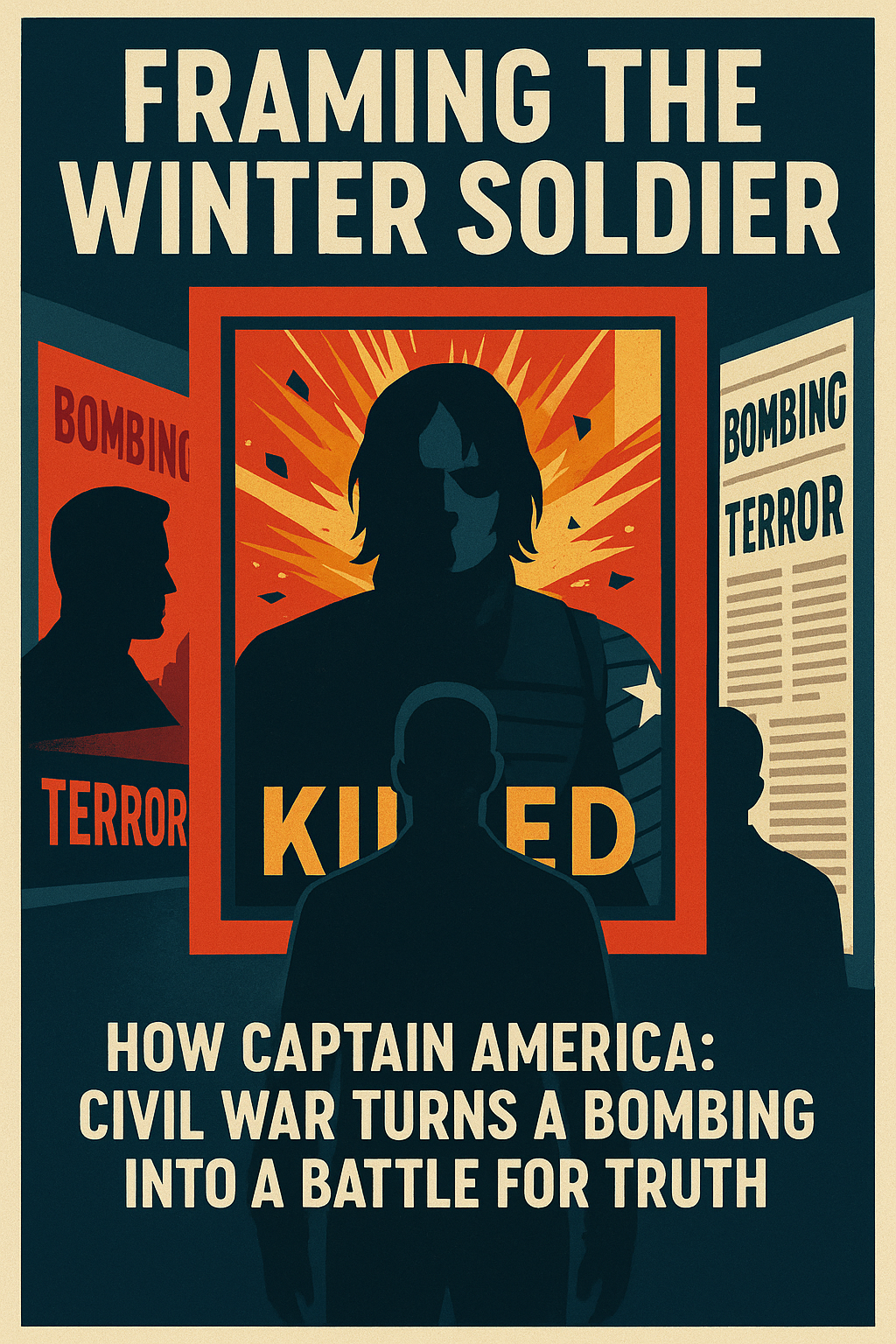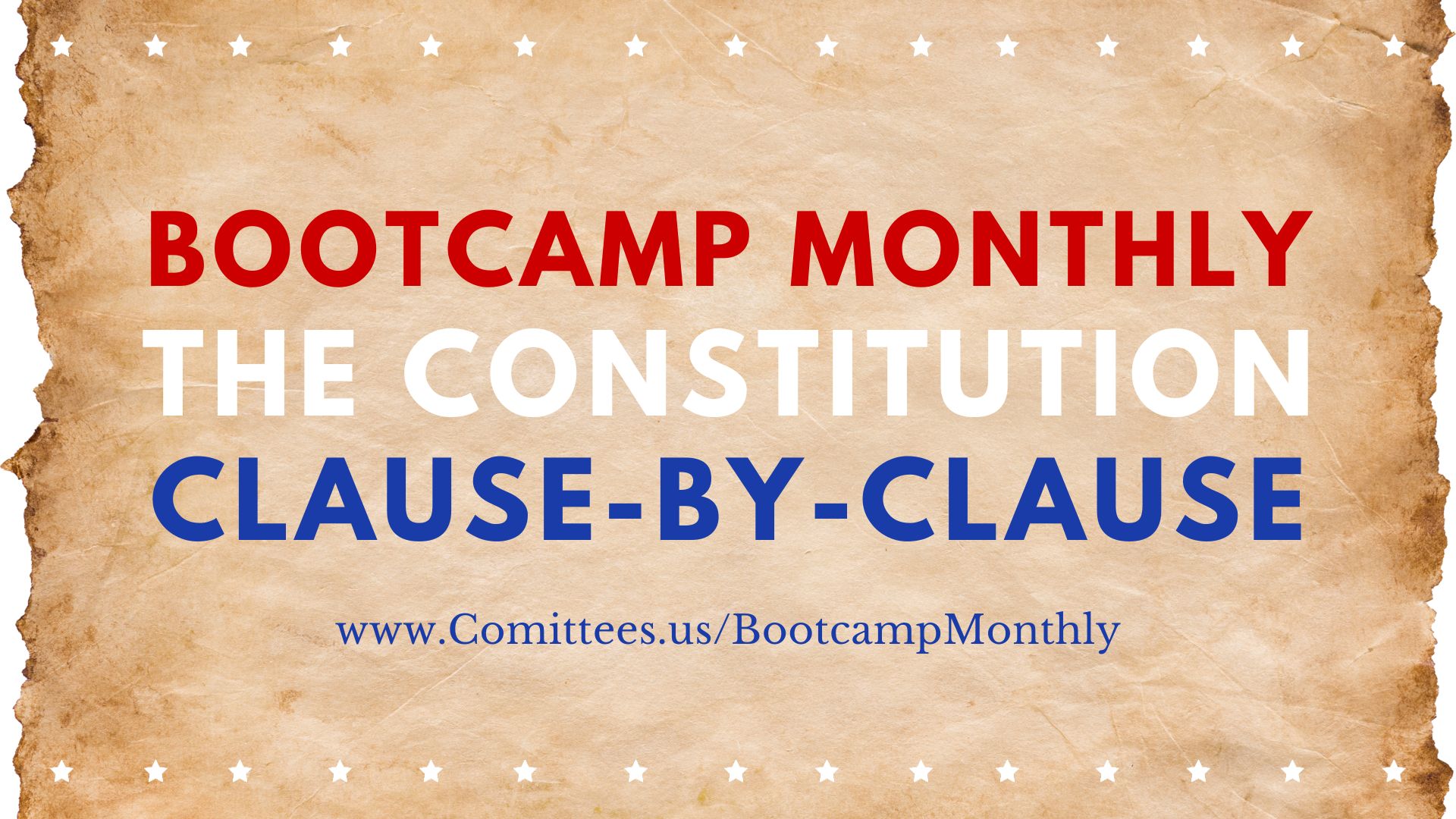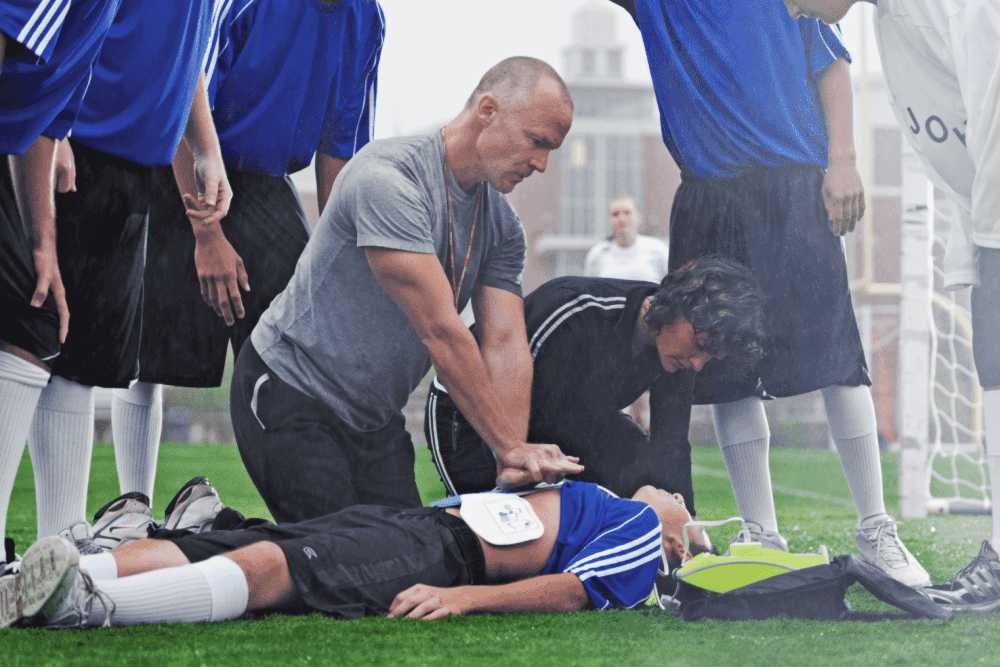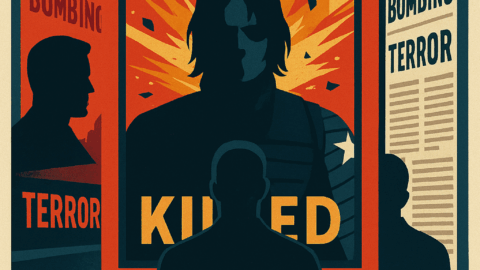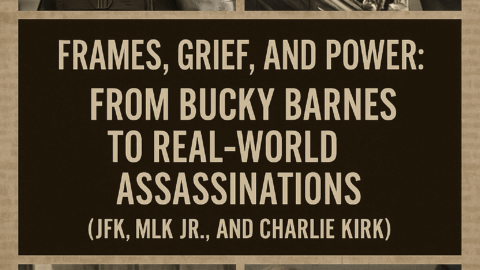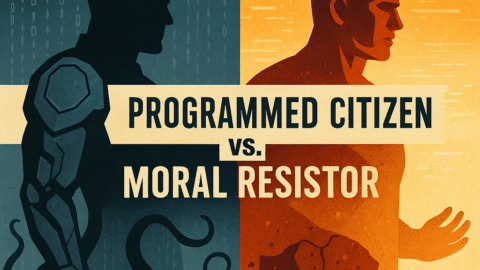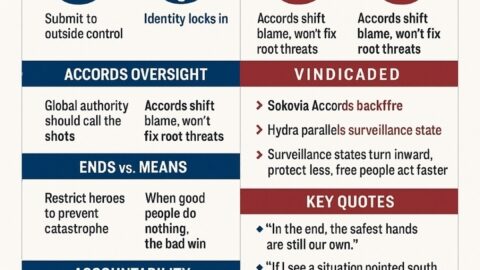In Captain America: Civil War, the moral tension isn’t about superpowers—it’s about perception, propaganda, and the courage to see through a manufactured lie. When the world turns on Bucky Barnes, framed for a bombing he didn’t commit, Captain America refuses to accept the narrative handed to him by the media, governments, and even his allies. While everyone else rushes to judgment, Steve Rogers slows down long enough to ask the most dangerous question in any age of manipulation: What’s really true?
That same spirit of discernment echoes through our present moment. In the aftermath of Charlie Kirk’s assassination, the rush to name culprits and craft a story feels hauntingly familiar. The flood of official statements, media speculation, and digital outrage creates a modern fog of war where speed replaces scrutiny. Yet, amid the noise, there are still those who take up Captain America’s mantle—not with a shield, but with questions.
Just as Steve refused to let Bucky be condemned without evidence, countless citizens today are refusing to let institutions script their beliefs. They are asking harder questions, vetting footage, tracing contradictions, and demanding proof rather than permission to think. In an era where algorithms frame perception as neatly as Hydra once framed a man, truth requires resistance. The new heroes are those willing to pause the narrative, rewind the footage, and look again.
When a bomb explodes at the Vienna signing of the Sokovia Accords—killing more than a dozen people, including King T’Chaka of Wakanda—the world is handed a ready-made culprit: James Buchanan “Bucky” Barnes, the Winter Soldier. A clipped, authoritative news bulletin does the rest: grainy video, a familiar face, a villainous label. Within minutes, outrage becomes policy—hunt, neutralize, contain.
Civil War uses that moment to teach a hard lesson: in crises, the fastest story beats the truest story. The film then spends its middle act unspooling how a plausible image becomes a political weapon, and how one man’s insistence on due process—Steve Rogers—keeps a friend (and a fragile world) from being swallowed by a lie.
The Perfect Scapegoat
“Officials have released a video of a suspect who they have identified as James Buchanan Barnes, the Winter Soldier…”
Bucky is the ideal patsy. He has the means (lethal training), the motive (a Hydra past), and a public reputation that fits the crime. The optics are too neat. High-value casualty (a king), global stage (the UN), and a familiar villain (the Winter Soldier) compress the political timeline: fear demands action now. This is how institutions “move fast” when the public is hurting—by narrowing complexity to a face.
The Bucharest Test: Image vs. Truth
The Bucharest sequence—Bucky’s first on-screen appearance—doubles as a forensic exam. It’s cut to make him look both dangerous and uncertain:
- “They’ve set the perimeter… they’re not planning on taking you alive.”
- “This doesn’t have to end in a fight.” — “Buck, it always ends in a fight.”
- “Stop—you’re going to kill someone.” — “I’m not going to kill anyone.”
Two things are true at once:
- He’s capable of exactly what the world fears.
- He’s not the thing they’ve decided he is—not anymore.
That tension is the film’s moral hinge. The camera gives you everything needed to believe the frame, and everything needed to doubt it. The question becomes who will slow down long enough to tell the difference.
How the Frame Works (Step by Step)
- Release an image.
A short video with a familiar face outruns caution. In politics, pictures beat paragraphs. - Amplify with symbol.
The death of King T’Chaka transforms a crime into an international trauma. The higher the profile, the faster deliberation collapses. - Name a villain who fits.
“The Winter Soldier” is a pre-loaded story. The past becomes the evidence. - Convert pain into policy.
The Accords shift from debate to necessity. “Oversight” hardens into detain first, ask later. - Let bureaucracy finish it.
Raids, warrants, black sites (the Raft). The process becomes the punishment.
Later, we learn Zemo engineered the proof. But by then, the frame has done its work—trust is broken, the Avengers are split, and the state has a new excuse to put superheroes on a leash.
Steve Rogers’ Refusal to Outsource Conscience
From the first bulletin, Steve won’t surrender judgment to the loudest tape:
- He goes to Bucky first. Not to justify him, but to verify.
- He risks personal standing and legal safety to ask for evidence over optics.
- He treats Bucky as a person, not a dossier.
This is not naïveté. It’s civic discipline. Steve’s ethic is simple: Don’t subcontract morality. “The safest hands are still our own” doesn’t mean “no rules”; it means responsibility cannot be replaced by permission slips. If you hand your judgment to a panel, you hand it—eventually—to whoever captures the panel.
Why Tony Stark is Persuasive—and Still Wrong Here
Tony’s argument sounds adult: “Compromise. Reassurance. That’s how the world works.” He’s carrying real guilt (Ultron, Sokovia) and a real body (Charles Spencer). He’s not scheming; he’s grieving. But grief makes oversight feel like penance—a way to prove you care without doing the slow work of truth.
Tony’s position collapses under its own logic:
- He backs the Accords, then breaks them to free teammates—proof he doesn’t trust the structure he just empowered.
- He wants neutral authority, but authority is never neutral; agendas change, and the very tool you build today can be used against the innocent tomorrow.
The Bucharest Clues You’re Meant to Notice
- Recognition: “You’re Steve… I read about you in a museum.” Bucky’s memory is not gone—it’s recovering. That recovery undermines the idea of a willing terrorist.
- Rules of engagement: Even in chaos, Bucky says, “I’m not going to kill anyone.” He fights to escape, not to massacre.
- Tactical realism: German Special Forces and a perimeter suggest a show of force calibrated for optics. “They’re not planning on taking you alive” reveals intent—administrative convenience over justice.
Each clue is a breadcrumb toward Zemo’s manipulation and away from the headline.
Due Process vs. Spectacle
The movie’s deeper argument isn’t “never regulate heroes.” It’s: Don’t let spectacle write the rules. Due process slows the stampede that follows a viral clip and a fresh grave. Steve’s loyalty to Bucky isn’t cronyism; it’s the first brake on a runaway system. Loyalty buys time for facts.
And when the facts arrive, they vindicate him:
- The video wasn’t proof of guilt; it was bait.
- The Accords emboldened hasty detentions; they didn’t prevent harm.
- The real threat wasn’t the man on-screen, but the man behind the screen—Zemo, a patient engineer of narratives.
What the Film Wants Us to Learn (Beyond the MCU)
1) Pictures persuade; they don’t conclude.
Ask for the chain of custody: who made it, who cut it, what’s outside the frame?
2) High-profile grief compresses law.
The bigger the loss, the stronger the temptation to replace justice with speed.
3) Institutions are tools, not oracles.
Panels and accords don’t absolve responsibility. They need moral operators—people who will refuse bad orders and act when permission lags behind duty.
4) Loyalty can be a civic virtue.
Standing with someone long enough to test the story is how truth survives pressure.
5) The safest hands aren’t unbound—they’re responsible.
Steve isn’t anti-law. He’s anti-outsourcing. Keep conscience awake, and keep the receipts.
The Bottom Line
Bucky’s frame job is the plot device; the real subject is how societies decide what’s true when they’re in pain. Civil War shows how quickly an image can become a verdict, how bureaucracies turn grief into leverage, and how fragile freedom becomes when we hand our judgment to “neutral” systems with shifting agendas.
Steve Rogers’ stubbornness saves more than a friend. It saves the idea that truth needs people brave enough to slow down the stampede—to knock on a door in Bucharest, to listen before labeling, to risk being called disloyal in order to be just.
In a world trained to trust the fastest clip, Civil War argues for something rarer: slow courage.
At-a-glance: the claim
A news bulletin names James Buchanan “Bucky” Barnes as the bomber at the UN in Vienna—70+ injured, 12 dead, including Wakanda’s king T’Chaka—showing a video identifying “the Winter Soldier” as the suspect. The film then uses the Bucharest scene and subsequent revelations to show this was a setup.
Scene & transcription anchors (what we hear)
- News report: “A bomb hidden in a news van…More than 70 injured…At least 12 dead, including Wakanda’s King T’Chaka…Officials released video of a suspect identified as James Buchanan Barnes, the Winter Soldier.”
- Bucharest dialogue: “They’ve set the perimeter…they’re entering the building…they’re not planning on taking you alive…Buck it always ends in a fight…you pulled me from the river…why…breach…stop, you’re going to kill someone…I’m not going to kill anyone.”
Point-by-point: How the film constructs the framing (and how Bucharest supports it)
1) Immediate attribution via media soundbite
- Mechanic: A short, authoritative news clip names Bucky and shows a still/video.
- Effect: Public attention hardens quickly—names + images = narrative.
- Why it works in film: Audiences accept audiovisual “evidence” faster than text; the clip’s brevity removes nuance.
2) High-value casualty amplifies outrage
- Mechanic: The dead include King T’Chaka of Wakanda—a prominent, sympathetic figure.
- Effect: Grief + anger intensify demand for accountability; nuance is sacrificed for urgency.
- Why it matters: When a national or symbolic figure dies, policy decisions (e.g., Accords) compress.
3) Visual ID (video) as presumed decisive proof
- Mechanic: Officials “release a video” showing the suspect—an implied chain of visual identification.
- Weakness: The film later reveals how video can be manipulated, cropped, and context-stripped.
- Narrative lesson: Video = persuasive but not infallible.
4) No immediate fact-checking in the political rush
- Mechanic: The storyline shows politicians and media rushing to conclusions before a thorough investigation.
- Effect: Politically convenient narratives (blame the super-soldier) travel faster than careful inquiry.
- Real-world analog: Crisis politics favors simple villains.
5) Bucharest scene gives the public a plausible image of Bucky in combat
- Mechanic: The Bucharest sequence shows Bucky in violent, disoriented action—breaking in, using lethal force, intense close-quarters combat.
- Effect: Visually primes the audience (and fictional public) to accept him as capable of an atrocity.
- Key beats from the transcription: “Buck it always ends in a fight” / “stop you’re going to kill someone” / “I’m not going to kill anyone” → show two things simultaneously:
- He is lethal and dangerous (what officials want the public to believe).
- He retains a sliver of conscience or confusion (what the audience ultimately learns to sympathize with).
6) Contrast between combat prowess and disorientation
- Mechanic: Bucharest intercuts precise killing moves with shots of Bucky’s blank or conflicted expressions.
- Effect: Ambiguity: he’s both capable and possibly not acting from autonomous volition. That ambiguity is exploitable by bad actors.
7) Political utility of a scapegoat
- Mechanic: Naming Bucky simplifies policy choices: “There is a terrorist among us; we must regulate the Avengers.”
- Effect: The Accords become emotionally compelling; oversight looks necessary and immediate.
- Narrative move: The film shows how political actors weaponize tragedy to get institutional control.
8) Zemo’s later orchestration (why this is framing)
- Mechanic (revealed later): Zemo engineers videos and situations to point blame at Bucky and to inflame Avengers against each other.
- Effect: The chain of “evidence” collapses when we learn the source and motive for the false proof: it was manufactured.
- Takeaway: The mechanics of framing are: manufacture footage → time to political need → public outrage → policy pressure.
9) Emotional dynamics—Tony & Steve
- Mechanic: Tony’s guilt and public pressure make him receptive to snap attributions; Steve’s loyalty to Buck inclines him to demand proof and humanize the accused.
- Effect: Personal stakes shape institutional responses—this is how policy turns personal and vice versa.
- Why it’s crucial: The film uses personal relationships to dramatize how societies handle—or mishandle—evidence in crises.
10) Due process vs. spectacle
- Mechanic: The movie contrasts slow, evidence-based investigation (Steve insisting on facts) with fast, spectacle-driven decisions (news + UN panel).
- Effect: The audience sees the costs of rushed attribution: innocent (or at least manipulated) people are punished; the real villain corrodes institutions by exploiting them.
Cinematic techniques that sell the frame
- Rapid cuts from footage to headlines to politicians—creates the illusion of causal certainty.
- Close-ups on grieving faces (Wakandans, Tony) trigger emotional reasoning.
- Ambiguous action editing in Bucharest—handheld, quick edits—makes Bucky look both menace and puppet.
- Selective exposition (news tells you the “facts”; the film withholds Zemo’s motive until later) forces viewers into the same rushed judgment as the fictional public.
Thematic implications & real-world lessons
- Video and images persuade faster than verification. Always ask: chain of custody? who posted it? what’s missing?
- High-value victims compress political time. Tragedies with symbolic casualties expedite policy-making—good checks get bypassed.
- Ambiguity about agency is exploitable. Combat skill + blank affect = perfect framing material for manipulators.
- Institutions are vulnerable to manufactured evidence. Legal safeguards and forensic standards exist for a reason—political urgency can short-circuit them.
- Personal relationships can be the last bulwark of truth. Steve’s refusal to accept the headline buys time for investigation; loyalty becomes a civic virtue in crisis.
Bottom line
Civil War shows a textbook framing campaign: release of evocative “evidence” + politicized outrage + rush to regulate = near-irreversible policy consequence (Accords) aimed at empowering oversight. The Bucharest scene supplies believable visual testimony (violent Bucky) while preserving narrative clues (confusion, conscience) that later allow the film to unmask the frame.
The movie is asking its audience to witness how quickly a public story can go from “image” to “truth” and how important due process, skepticism, and human loyalty are when institutions rush to judgment.

